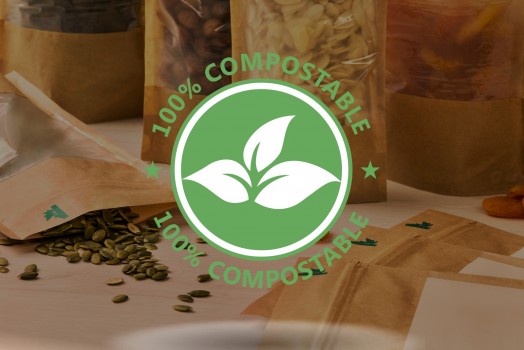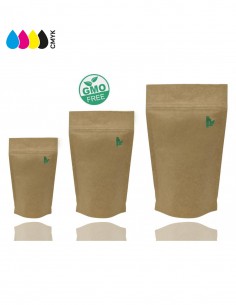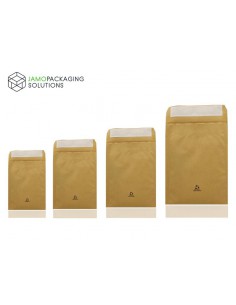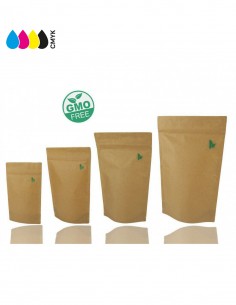- Eco-friendly pouches
- 0 likes
- 5257 views
- 0 comments

Composting is an incredibly complex natural process, involving a wide array of microorganisms and a plethora of chemical reactions. It is also amazingly simple way of reducing waste, requiring almost no effort or costly equipment. While understanding the entire biochemical principles behind composting can be daunting, we want to show you that anyone can try reducing your effect on nature in this way. We hope that this will serve as a short introduction into both the science behind biodegradation, but also will be a go-to reference when it comes to preparing your own compost pile.
Start with the basics
Let’s start from the very beginning. Composting, also known as biodegradation, is a biochemical process of breaking down substances and natural materials, with the help of variety of microorganisms, such as bacteria or fungi. As a result these materials are decomposed into basic nutrients, which then might be used to enrich the soil. It means that you can get rid of your unwanted trash in the most eco-friendly manner: by turning it, at your own place, into completely natural fertilizer, which can be then used to help nurturing your plants. You also take off the strain of your trash from the garbage disposing companies, minimize the energy needed to process and recycle them. Remember that just by throwing away your empty bag into the trash can you create a cascade of further issues. You need containers to store the garbage, people to take them, fuel and vehicles to transport, facilities to process and either destroy or reuse the materials. All of that for each and every piece of trash produced by our society!
We are sure that you are already invested in the movement of reducing waste. While we cannot completely stop using pouches and bags, we surely can work together, in order to secure the health of our planet. Our packaging solutions are biodegradable and completely compostable, because we decided to invest our time and money into picking only the best materials that fit these labels. So, if you wish to dispose of our pouches, we want to propose to you to read further down and learn how to compost them in the best possible way.
Meet our little friends
When it comes to the organisms that help with composting, we divide them into three levels, depending both on their size, but also on what their role is in the entire process. Third-level decomposers, which we can also call macroorganisms, are animals that are usually big enough to spot with a naked eye. Their job is to mechanically break down the material by chewing, shearing or tearing it apart. This group consists of animals such as ants, woodlice, spiders, beetles or slugs. If we go down, to the second-level decomposers, we will find much smaller organisms, such as springtails, mites or a large group of protozoa. They can eat and process both organic materials, as well as the even smaller, first-level decomposers, such as bacteria or fungi. These are, as a matter of fact, the smallest ones of the bunch, but also the most numerous ones. They have the ability to break down and process the biomaterials and expel the basic nutrients into the soil surrounding them.
Oxygen – vital part of the process
Let’s stop for a second here. Bacteria on the first level can be divided into two groups: aerobic and anaerobic. Aerobic bacteria are the most important ones when it comes to composting process. They are able to convert organic material into the nutrient-rich soil that we want. But there is a catch – they require oxygen in order to effectively conduct this process. In order to allow the oxygen to reach high enough level – around 5% - the entire compost pile must be aerated. You can either buy an aerator or just turn it over again and again, rustling the pile and letting fresh air inside. Otherwise, the oxygen level inside will drop and end up slowing the decomposing process for up to 90%! The other group, anaerobic, is less desirable for us. Instead of decomposing, they take care of the fermentation process. By creating a bunch of amines and acid molecules they tend to make the entire pile smell fermented and rotten and will turn the nice, brown compost into black, sloppy mess. Fortunately, all you have to do to prevent it is to preserve a proper mix ratio – more about that later – and aerate the pile frequently.
We also want to direct your attention to the group of aerobic bacteria called Actinomycetes, as they play a major role in the biodegradation process. As they make for the bulk of the entire first-level decomposers, they tend to feed on the materials that are harder to degrade by the other types of microorganisms. A byproduct of their work is a chemical called geosmin – a bicyclic alcohol that has a distinctive musty, earthy aroma of freshly dug up soil or rain on a dry earth. What you should remember about them is that they work best in the range between 20º to 50ºC and they do not enjoy high moisture conditions. While the temperature is pretty easy to maintain, especially indoors, we should discuss the ways of keeping the proper humidity as we talk about preparing a compost mixture.
Time to get dirty!
The theory behind preparing your own biodegradation mixture is quite simple. All that you need, in order to create a pile, is a proper storage place. It should be in a warm place with a, preferably, constant temperature of around 20-30º C if you are opting for an indoor one, or a bigger, protected
place outside, in the garden. Indoor bins are usually around 1 square foot, while the outdoor ones are usually around triple the size. No matter which one do you pick, remember to protect it well from the animals! Make sure it can be either closed or fenced, as pets and wild animals love to dig around and destroy your pile. Finally, make sure to get a waterproof lid or roof on top of it, as you should never let too much water into your mixture.
Compost consists of two main components. “Browns” are, to put it simply, dry, plant-based materials. They can be either natural (for example twigs or dead leaves) or man-made (like used pouches, old newspapers or unbleached tissues and napkins). On the other hand we have “greens”,
which consists of fresh “waste”, such as fruit peels, vegetable scraps or freshly cut grass. One thing that may surprise you – coffee grounds also counts as “greens”! As you can see, you can add almost anything to it, as long as it is an organic material. That is also the reason why we opted for fully biodegradable resources to design our packaging solutions. After all, you can just chuck the entire bag inside (even though we suggest to rip and tear it apart, to make it easier for the microorganisms to break it down!), as you do not have to worry about adding anything non-biodegradable to the pile.
Optimal conditions – foundation of proper biodegradation
Approximately 70% of the entire mixture should be “browns”, while the rest would be “greens”. Why do we need specifically such composition, you might ask? That is because “browns” will introduce the bulk of carbon molecules, while “greens” are rich in nitrogen. Carbon is the basis of the entire branch of organic chemistry and is the second – after oxygen – the most ubiquitous element in the living organisms. It only makes sense that the materials we want to add to our pile should be very rich in carbon – so make sure to add much more dry leaves and shredded paper to your mix. On the other hand, nitrogen is extremely important for a simple reason. Aerobic bacteria – and especially those from the Actinomycetes group – require a lot of nitrogen in their diet. It allows them to synthesize multiple proteins at a rapid pace, allowing for their fast growth, proliferation and – by extension – faster decomposition of our materials. So the proper mixture – as we said, 70-30 of browns and greens – is the most important part of your pile. We also already talked about the aeration and the importance of oxygen, but we should also mention the last part, which is humidity. A lot of microorganisms live in water films that surround different parts of our soil. In order to allow them to do so, we need our pile to get wet, but not soaking. You should strive for a moisture level of around 50-60%, which means that your bin should be just a bit moist on top. Do not top it off with water, do not get it soaking – just enough to make it slightly wet, like the top of a sponge.
Summary – short and sweet
As we have mentioned earlier, composting is an amazing way of getting rid of your unwanted, used packaging or other types of garbage. It does not only allow you to reduce the amount of garbage sent to landfills, but also it leaves you with plenty of natural fertilizer to enrich the soil of your plants. Remember to find and prepare a proper place for your compost pile, one that will be comfortable for you to leave undisturbed for quite some time, with the exception of aeration every week or two. Make sure to create a good mixture of greens and browns, remember about proper moisture level and… well, that is pretty much it! By keeping the proper balance of carbon and nitrogen, water and temperature, letting enough oxygen into the bin and manually tearing or cutting the material you want to decompose; you will greatly improve the speed of the process. So what are you waiting for? Go ahead and give it a try!







Comments (0)